2016 January
About Andrew Cusack
 Writer, web designer, etc.; born in New York; educated in Argentina, Scotland, and South Africa; now based in London.
Writer, web designer, etc.; born in New York; educated in Argentina, Scotland, and South Africa; now based in London. read more
News
Blogs
Reviews & Periodicals
Arts & Design
World
France
Mitteleuropa
Knickerbockers
Argentina
The Levant
Africa
Cape of Good Hope
Netherlands
Scandinavia
Québec
India
Muscovy
Germany
Academica
Sieg für die Schönheit
Sieg für die Schönheit
Alles Sal Reg Kom
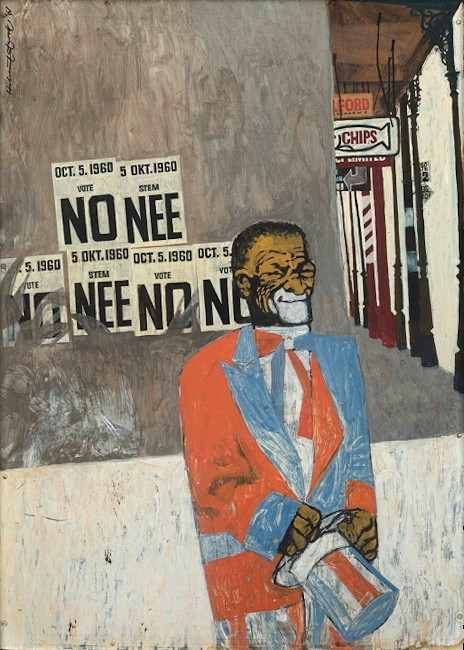
1961; Acrylic on board, 34.8 in. x 24.8 in.
A man festively attired in a Tweede Nuwejaar outfit in patriotic colours (orange, white, and blue) stands in front of a side wall in Cape Town bearing monarchist posters urging voters to vote ‘No’ in the 1960 republic referendum.
The painting’s title – Alles Sal Reg Kom – means “everything will be alright”.
Wednesday 27 January

– Margaret Beaufort was one of the greatest women England ever produced, but her legacy has been plagued by misogyny combined with Protestant suspicion of her Catholic piety. Leanda de Lisle delves into the question of whether she was a hero or a villain.
– Speaking of powerful women, James Panero’s examines the monument to Joan of Arc on New York’s Riverside Drive. The artist was a female sculptor, Anna Hyatt Huntington, whose statue of El Cid in the forecourt of the Hispanic Society on Audubon Terrace is one of the finest sculptural arrangements in the New World.
– Lent is about to stare us in the face, but so far as I am concerned we are allowed to wallow in Christmas cheer until Candlemas comes on 2 February. Dr John C Rao (of St John’s University and the Roman Forum) offers us a reflection on the Christmas Crèche and its origins as Saint Francis’s giant “F.U.” to Cathar heretics, while putting the thinking behind that great saint’s actions in a modern context.
– It’s good to see neglected favourites receive a bit of unexpected attention. One such is the Irish writer George Russell, more often known by his pen name ‘Æ’. The Irish Ambassador to Great Britain, Dan Mulhall, begins a series on Irish writers and 1916 by looking at Æ in the context of the Rising.
One project that TCD or UCD – or anyone for that matter – needs to take on is digitising the entirety of The Irish Statesman, the journal mostly edited by Russell which presented a fascinating counterpoint to the more common narratives, first in 1919/20 and then from 1922 to 1930.
– And finally, some Goethe love from The New Yorker’s Adam Kirsch.
Darkness
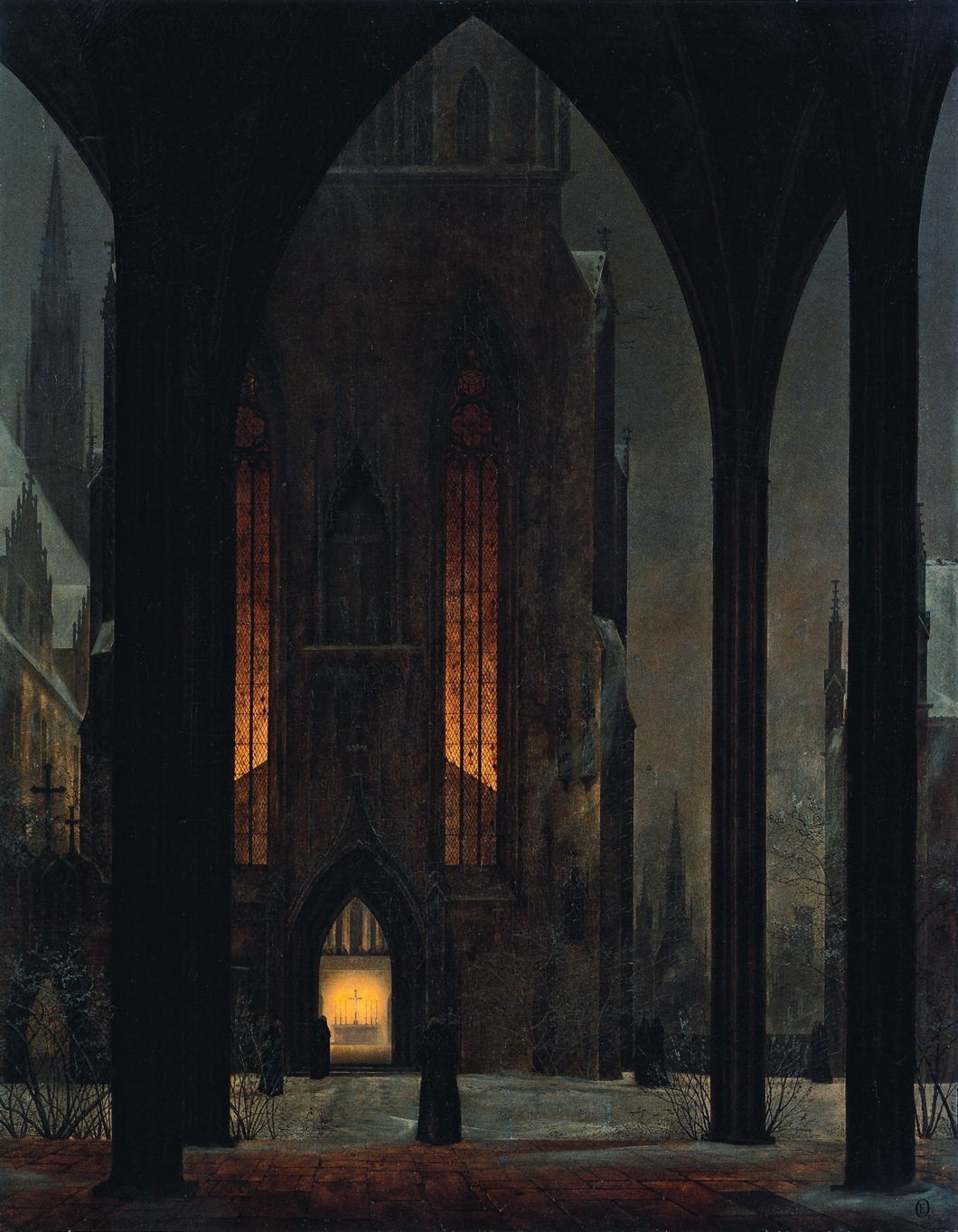
I had a dream, which was not all a dream.
The bright sun was extinguish’d, and the stars
Did wander darkling in the eternal space,
Rayless, and pathless, and the icy earth
Swung blind and blackening in the moonless air;
Morn came and went—and came, and brought no day,
And men forgot their passions in the dread
Of this their desolation; and all hearts
Were chill’d into a selfish prayer for light:
And they did live by watchfires—and the thrones,
The palaces of crowned kings—the huts,
The habitations of all things which dwell,
Were burnt for beacons; cities were consum’d,
And men were gather’d round their blazing homes
To look once more into each other’s face;
Happy were those who dwelt within the eye
Of the volcanos, and their mountain-torch:
A fearful hope was all the world contain’d;
Forests were set on fire—but hour by hour
They fell and faded—and the crackling trunks
Extinguish’d with a crash—and all was black.
The brows of men by the despairing light
Wore an unearthly aspect, as by fits
The flashes fell upon them; some lay down
And hid their eyes and wept; and some did rest
Their chins upon their clenched hands, and smil’d;
And others hurried to and fro, and fed
Their funeral piles with fuel, and look’d up
With mad disquietude on the dull sky,
The pall of a past world; and then again
With curses cast them down upon the dust,
And gnash’d their teeth and howl’d: the wild birds shriek’d
And, terrified, did flutter on the ground,
And flap their useless wings; the wildest brutes
Came tame and tremulous; and vipers crawl’d
And twin’d themselves among the multitude,
Hissing, but stingless—they were slain for food.
And War, which for a moment was no more,
Did glut himself again: a meal was bought
With blood, and each sate sullenly apart
Gorging himself in gloom: no love was left;
All earth was but one thought—and that was death
Immediate and inglorious; and the pang
Of famine fed upon all entrails—men
Died, and their bones were tombless as their flesh;
The meagre by the meagre were devour’d,
Even dogs assail’d their masters, all save one,
And he was faithful to a corse, and kept
The birds and beasts and famish’d men at bay,
Till hunger clung them, or the dropping dead
Lur’d their lank jaws; himself sought out no food,
But with a piteous and perpetual moan,
And a quick desolate cry, licking the hand
Which answer’d not with a caress—he died.
The crowd was famish’d by degrees; but two
Of an enormous city did survive,
And they were enemies: they met beside
The dying embers of an altar-place
Where had been heap’d a mass of holy things
For an unholy usage; they rak’d up,
And shivering scrap’d with their cold skeleton hands
The feeble ashes, and their feeble breath
Blew for a little life, and made a flame
Which was a mockery; then they lifted up
Their eyes as it grew lighter, and beheld
Each other’s aspects—saw, and shriek’d, and died—
Even of their mutual hideousness they died,
Unknowing who he was upon whose brow
Famine had written Fiend. The world was void,
The populous and the powerful was a lump,
Seasonless, herbless, treeless, manless, lifeless—
A lump of death—a chaos of hard clay.
The rivers, lakes and ocean all stood still,
And nothing stirr’d within their silent depths;
Ships sailorless lay rotting on the sea,
And their masts fell down piecemeal: as they dropp’d
They slept on the abyss without a surge—
The waves were dead; the tides were in their grave,
The moon, their mistress, had expir’d before;
The winds were wither’d in the stagnant air,
And the clouds perish’d; Darkness had no need
Of aid from them—She was the Universe.
This year — 2016 — will be the two-hundredth anniversary of the Year without a Summer, caused by the eruption of Mount Tambora in the Dutch East Indies the year before.
The extremely high levels of volanic material in the atmosphere led to darker skies which meant colder temperatures and failed harvests. Brown snow was reported in Hungary and red snow in Italy.
But the abnormalities in the sky were also responsible for the spectacular sunsets that inspired artists like Caspar David Friedrich and J M W Turner and the unceasing rain that provoked Mary Shelley to write Frankenstein and Lord Byron to write ‘Darkness’.
It’s no coincidence that, soon after this year of darkness, John Polidori published his book The Vampyre and the modern concept of this undead creature began to haunt the gothic imagination.
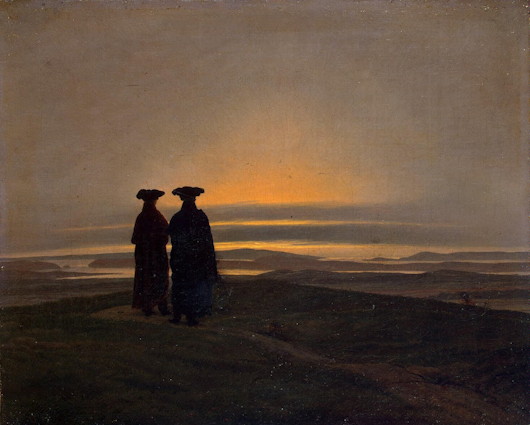
A memorial to Conscience
Sharon Jennings’s new play on Franz Jägerstätter
It is often said that one man’s terrorist is another man’s freedom fighter — but what inspires the man who refuses to fight? Is he a coward? A man of conscience? Or a mere contrarian who goes too far? Sharon Jennings’s new play, ‘Memorial’, explores the surprisingly not yet well-known story of Blessed Franz Jägerstätter, an Austrian executed during the Second World War for his conscientious objection to military service under Hitler.
This clever telling frames the martyr’s life mostly in retrospect, as the Mayor (played by the very capable Joe Cushley) assembles the leading villagers of St Radegund (actors Richard Evans, Carianne Dunford, Richard Ward, and Meg Depla-Lake) to compile the list of names to be etched permanently in stone on the village’s war memorial. The list is finalised but there is one name that cries out to be remembered: their poor lamented Franz.
We meet the main character (played by Felix Dunning) both through the memories of his rural contemporaries and his own letters home to his wife during basic training. For his refusal to take the military oath of absolute obedience to Adolf Hitler, he is thrown into prison. ‘Memorial’ reaches its apex in the confrontation between the uncomplicated but principled Franz and his cunning and clever military judge (a role brilliantly performed by Gary Merry). The chilling battle between good and evil is made all too real and the viewer is reminded of the battles of conscience ongoing in our own lives and the lives of thousands of others every single day.
In the end, it is through the lens of his fellow villagers that we remember Franz. Why can’t he just sign the dotted line? All the rest of us did. It’s a mere formality. We didn’t have a choice!
Deviant? Rebel? Hero? Whatever we think of men like Franz, in this play Sharon Jennings has carved and crafted a memorial to conscience — a healthy but haunting reminder of that freedom which always remains even when all others disappear.
The Accession
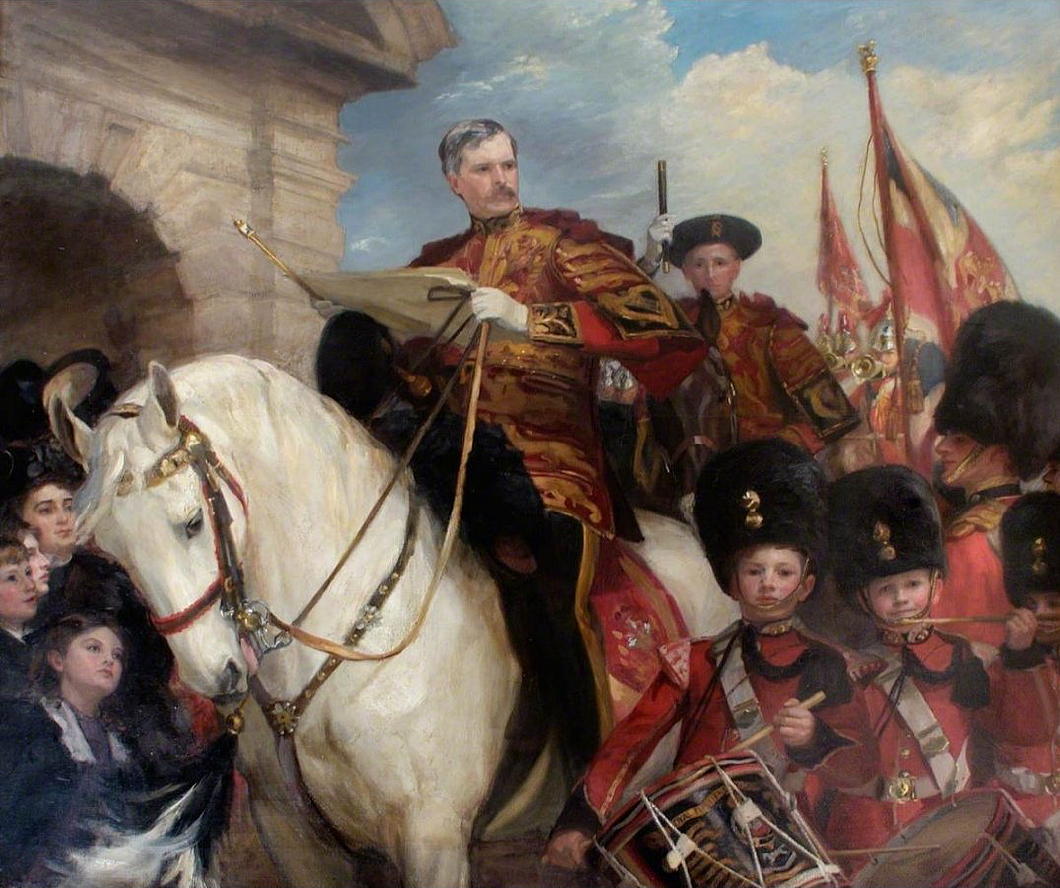
c. 1911; Oil on canvas, 68 in. x 76.9 in.
A triumphant painting, but a last hurrah. The central figure is Sir Nevile Wilkinson, the last ever Ulster King of Arms & Principal Herald of Ireland, exercising the duties of his office by proclaiming the accession of the new king at Dublin Castle.
The Anglo-Irish Treaty and its legislative acts neglected to make provision for transferring this ancient office to the new Irish Free State, but Sir Nevile carried on regardless for nearly two decades, even issuing two dozen grants of arms on the day before his death in 1940.
After his death, the Oireachtas created the office of the Chief Herald of Ireland to continue the granting of arms, and in some sense the Chief Herald is a spiritual successor to the Ulster King of Arms.
Die Staatsrede
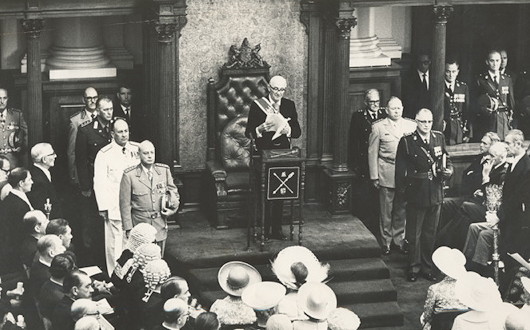
Staatspresident Jacobus Johannes Fouché giving the staatsrede from the throne of the Senate within the Houses of Parliament in Cape Town.
What is now the State of the Nation Address has its origins in the speech from the throne (in Afrikaans staatsrede meaning “state reasoning/rationale”) setting out the Government’s legislative programme for the year. The high point of the State Opening of Parliament, it was originally given by the Governor-General (or, in 1947, by the King of South Africa himself) but with the abolition of the monarchy in 1961 the sovereign’s vice-regal representative was abolished and replaced by the Staatspresident as chief officer of the South African state.
Giving a speech from an actual throne was considered too monarchic for a republican polity, so – like in the Boer republics of old – presidents gave their staatsredes standing. Here, State-President Fouché is flanked by the chiefs of the defence staff and police, the Serjeant-at-Arms with the mace, and the Gentleman Usher of the Black Rod.
Of course, much of this was abolished in the 1980s with the constitutional innovations as a last-ditch attempt to entrench apartheid. South Africa is now on its third constitution since the above photo was taken.
It reminds me of how in Ireland almost all the traditions of the Viceroy (viz. the Viceregal Guard of Battleaxes, etc.) were abolished not by the Saorstát or Éire but by the British themselves – in their case by penny-pinching Victorians who found Dublin an easy target for cost-cutting.
View from a Window
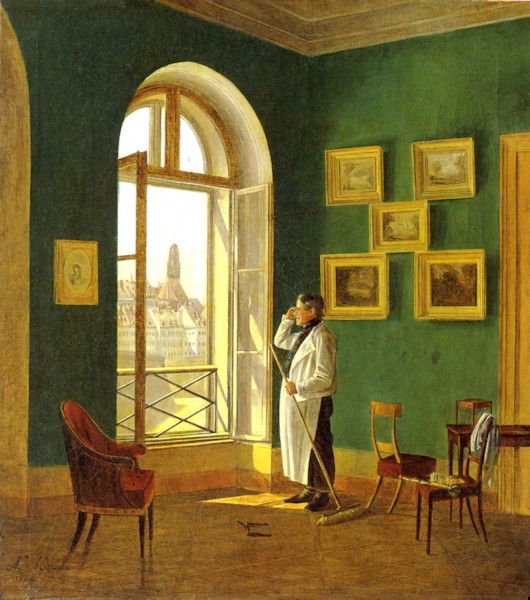
1830; Oil on canvas, 15½ in. x 13½ in.
I love the underappreciated Biedermeier, whether in art or literature, and this is a very Biedermeier painting.
The painter’s father, Charles de Moreau, was an architect – indeed he designed the very building that the son depicts here. As it happens, the painting now hangs in the Wien Museum am Karlsplatz, across from the main building of the Imperial & Royal Polytechnic Institute (now the Vienna University of Technology) which his father also designed.
Nikolaus painted this scene when he was twenty five, and he died just four years later not having reached his thirtieth year.
The Rova of Antananarivo
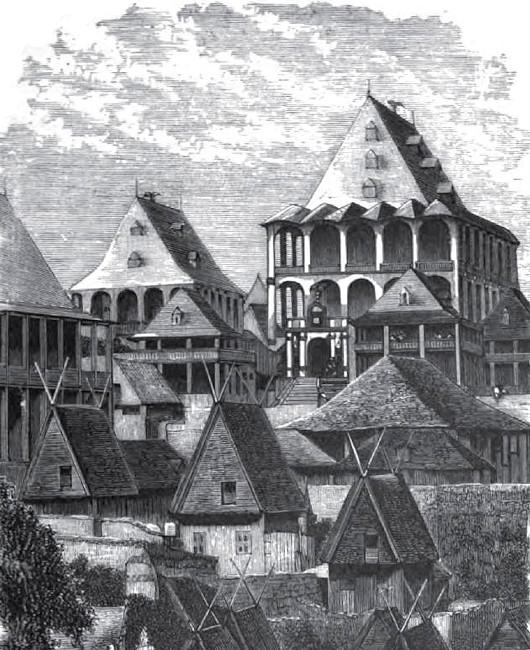
The Rova of Antananarivo
The Tranovola (left) and Manjakamiadana (right) in the Rova of Antananarivo.
The Manjakamiadana (“Where It is Pleasant to Rule”) was the royal residence, later pretentiously clad in stone by Protestant missionaries, while the Tranovola (“Silver House”) was where the nefarious Rainivoninahitriniony received foreign diplomats after the nobles’ coup of 1863.
His complicity in the supposed regicide of that year — no one’s really quite sure what happened to Radama II — eventually led to his downfall two years later. His younger brother Rainilaiarivony proved a more skilful political operator, succeding Rainivoninahitriniony as prime minister and arranging his own marriage to the last three queens of the Merina kingdom of Madagascar.
Monday 18 January

– Architectural historian Catesby Leigh looks at Ralph Adams Cram and Pittsburgh’s gothic architectural legacy.
– In October for the first time ever Polish voters handed a parliamentary majority to a single party, putting the Law and Justice (PiS) party in power after nine years in opposition. But, alarmed by the new government’s attempts to correct the stacking of state media by their political opponents, western European powers have attacked the new government and suggested it be investigated by the European Union.
The PiS delegation of the European Conservatives & Reformists Group in the European Parliament has released a measured statement asking What is really happening in Poland? Given recent events in Cologne, however, Polish fans at a volleyball match in Berlin viscerally suggested the Germans should get their own act in order before criticisng others.
– Polish academic Artur Rosman explores both the history and future of the pro-life movement in America, citing the New York Times’s Kristen Dombek’s surprise at discovering that abortion is not an exclusively conservative concern:
Among those of us who wish to protect access to abortion, it’s easy to feel that “right to life” language is a cover for an attack on feminism. It’s a feeling supported by a common story about history: The anti-abortion movement began after Roe v. Wade, because conservative evangelicals were threatened by women’s newfound power over their bodies. What else could explain the movement’s swift rise in the decade following the Supreme Court’s decision, if not a widespread reaction against equal rights? […]
[I]t’s hard to imagine a country where the most prominent voices against abortion were Catholic physicians, and evangelical Protestants were either in favor of lifting restrictions on abortion, or didn’t really care. A country where Democrats and the Black Panthers opposed abortion, and Ronald Reagan, like most conservatives, supported it. Where more men than women supported legalizing abortion, and Hugh Hefner was one of those men, leading one activist to call legalized abortion the “final victory of the Playboy philosophy.” Where opposition to abortion found common cause with opposition to the exploitation of women, to the abandonment of the poor, to big business and to the Vietnam War.
– And finally, Sam the Eagle has a message for all the prospective candidates in the American presidential election:
Remembering James III & VIII
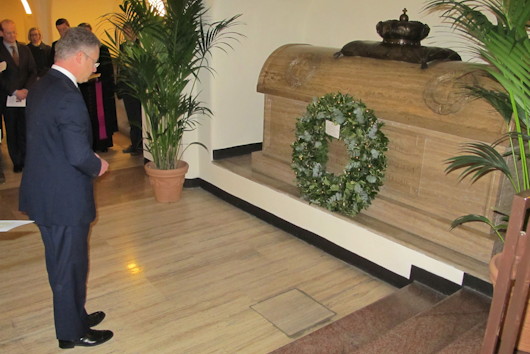
On the two-hundred-and-fiftieth anniversary of his state funeral in Rome, James III & VIII was remembered with a wreath-laying by Her Majesty’s Ambassador to the Holy See, Nigel Baker. The message on Nigel’s wreath read simply ‘In memoriam – James Francis Edward Stuart – ‘The Chevalier’ – 1688-1766’.
As the Ambassador notes in his blog post:
[O]ur simple wreath-laying ceremony was, in a way, one of historical reconciliation. The Chevalier always considered himself a patriot, and his court in exile welcomed Britons of all political and religious stripes. His younger son, Henry Benedict, Cardinal York, received a pension from the British Crown after his lands had been seized by Napoleon, and the Prince Regent offered to contribute to the magnificent Stuart monument by Canova that can still be seen in St Peter’s. The tomb in the crypt where I laid the wreath was restored by Queen Elizabeth the Queen Mother, through the good offices of my predecessor, Sir D’Arcy Osborne, in the early 1940’s. And in 2012 HRH The Duke of Gloucester unveiled a restored Coat of Arms of Cardinal York in the Pontifical Scots College, where the original Stuart gravestones had been transferred.
James III was the last of the Jacobite claimants to the English, Scots, and Irish thrones to be recognised by the Pope. He was succeeded in the line by his eldest son Charles (Bonnie Prince Charlie) and, after Charles’s death, by James’s second son Henry, who — having been ordained a priest, then a bishop, and being created a cardinal — was generally known as the Cardinal Duke of York.
Cardinal Comastri — Archpriest of St Peter’s Basilica, President of the Fabric of St Peter’s, and Vicar General of the Vatican City State — took part in the ceremony and also present were Lord Nicholas Windsor, and the Rectors of the Venerable English College, the Pontifical Scots College, the Pontifical Irish College, and the Pontifical Beda College, the Polish Ambassador to the Holy See (in honour of James’s wife Queen Maria Clementina), and the Irish Ambassador to the Holy See.
“The presence of the Irish ambassador to the Holy See,” Nigel notes, “also reminded us of the importance of commemorating together, rather than remembering apart. The past leaves many wounds. But do not underestimate the healing power of history and remembrance, done well.”
Also a sign, one might add, of what good value we get out of this most unique of British diplomatic postings.
Interior of the Groote Kerk
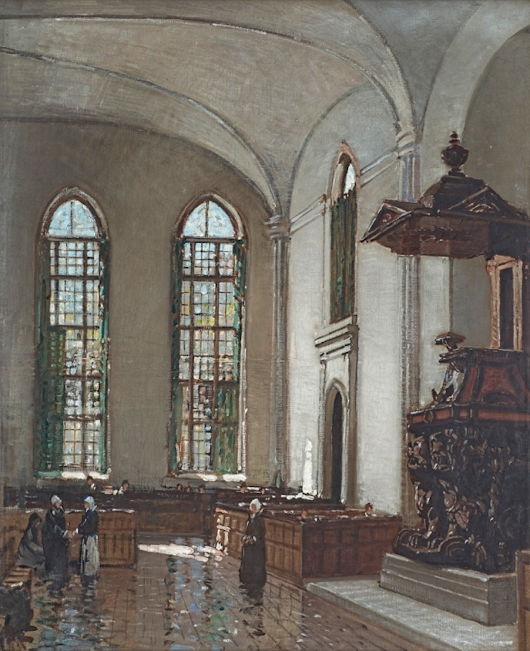
1916; Oil on canvas, 29½ in. x 24½ in.
Though the painting is just a hundred years old, Gwelo Goodman depicted the scene as if in the late seventeenth century — when the Groote Kerk was first built.
While the body of the church was replaced in the 1840s, the elders of this most senior Nederduits Gereformeerde gemeente wisely kept the stunning baroque pulpit, the work of the Cape’s greatest sculptor Anton Anreith.
Naples
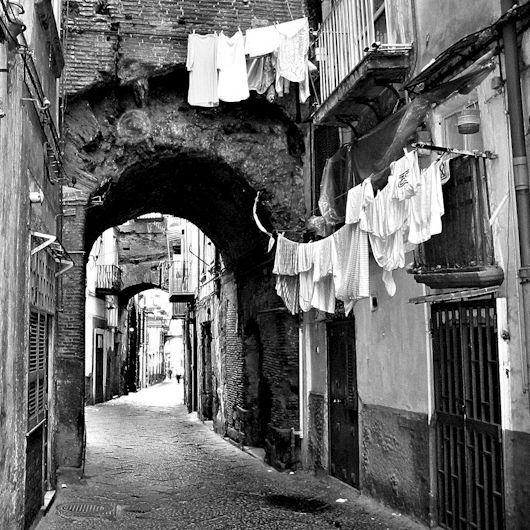
THERE ARE CITIES that defy the centuries; time does not change them. Empires succeed each other, civilisations leave their remains in them like geological strata, but they preserve their character through the ages, their peculiar ambience, the sound and rhythm which distinguish them from all other cities upon the earth. Naples is one of these cities, and it appears to the traveller today, as it was in the Middle Ages, and doubtless a thousand years before, half-African, half-Latin, with its terraced alleys, its street-cries, its smell of olive oil, charcoal, saffron and frying fish, its sun-coloured dust, the sound of bells ringing on the necks of horses and of mules.
The Greeks founded it, the Romans conquered it, the barbarians despoiled it, the Byzantines and the Normans each in turn took possession of it as masters. But they did no more than modify a little the architecture of its houses and add certain superstitions, a few legends, to the traditions of its streets.
The population is neither Greek, Roman nor Byzantine; the people are Neapolitan in perpetuity, a population distinct from all others in the world. Their gaiety is but a facade concealing the tragedy of poverty, their magniloquence an accent relieving the monotony of the daily round, their leisure a virtue in refusing to pretend to be busy when there is in fact nothing to do; its population is life-loving, meeting the setbacks of fate with guile, with a gift of speech and a contempt for all things military because peace never becomes boring. …
Tuesday 12 January

– Imagine you find out your mother has been killed. Then imagine her killer not only goes unpunished but that he’s subject to a continual stream of awards and honours. At school your son is handed a leaflet promoting the man who ended his grandmother’s life. The only objectors (Catholics and Holocaust survivors) are easily brushed aside.
This isn’t an alternate universe: this is Belgium today, as the New Yorker reports. (via M.B.D.)
– Fr Edmund Waldstein relates a stimulating dialogue upon Star Wars between Over-Bearing, Past-Bearing, and Baring (with a cameo appearance from Duff Cooper).
– I’ve mentioned Tolkein and his love of Finnish before. More recently, the BBC inquired about Finland’s influence on the writer.
– “It’s the most nauseating display in American public life,” says Kevin D Williamson in his splendid jeremiad, “and I write that as someone who has just returned from a pornographers’ convention.”
– Fredrik de Boer puts his head above the parapet and gives us a little insight into how things work.
– And finally, some good news: a study claims French is set to overtake Chinese as the world’s most widely spoken language by 2050. (But, as P.E.G. noted in 2014, the methodology is a bit dodgy.)
Let’s hope they’re reading Bossuet rather than Voltaire.
Ball
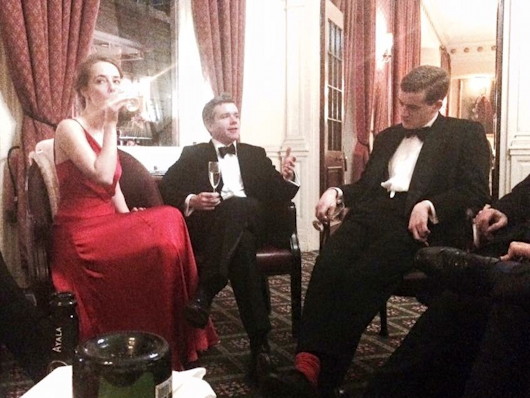
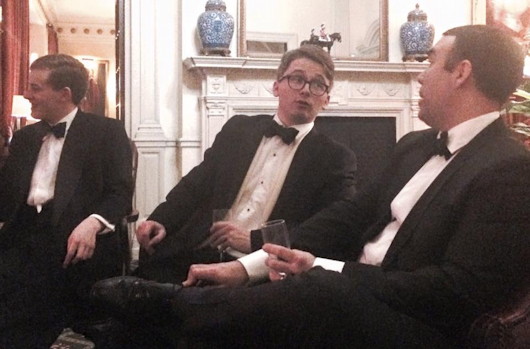
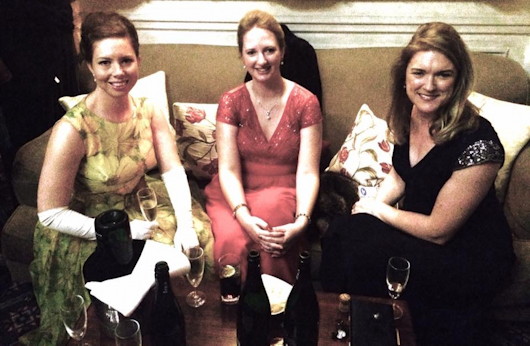
The Cusackian table used to be the only one having our pre-ball drinks at the Cavalry & Guards Club (thanks to Maj Ibbs & Capt de Stacpoole) but this year the place was choc-a-bloc with ballgoers. Our ladies were looking particularly lovely, though there were moments when various of their fur accoutrements were redeployed as judges’ wigs and sentence was passed on those worth of condemnation.
Despite the rather late hour I left the after-party, I somehow made it to the 11 o’clock mass at the Oratory the following morning and noticed a somewhat depleted congregation (though added to by the presence of Gerald Warner up from Scotland). Very wisely the ball organisers arrange a special afternoon mass at 2 o’clock for survivors, but by the time it commenced I had not only already fulfilled my Sunday obligation but also downed a delicious plate of pappardelle and was en route back home to bed and further recovery.
Friday 8 January 2016

– Ross Douthat’s sensitive and thoughtful commentary on the state of the Catholic church (in the New York Times, of all places) has previously sparked apoplexy on the part of liberals, hilariously inspiring a host of bien-pensant establishment lefties to point out he has “no professional qualifications for writing on the subject”.
In a recent blog post, Douthat points out how difficult it is to engage in dialogue with lefty Catholic thinking given that it often assumes we can reinterpret anything whenever we want while ignoring centuries of fervent intellectual inquiry and church teaching. For these liberals, it is always Catholicism: Year Zero.
– The British writer Tibor Fischer is no conservative, but he’s often written how ridiculous it is for people to claim the Viktor Orbán is a dictator, whether in the Guardian or in Standpoint. (I myself had to take to the pages of the Irish Times to defend the Hungarian PM.)
Now Fischer writes in the Telegraph asserting that Viktor Orbán is no fascist: he’s David Cameron’s best chance at reforming the European Union.
– Still in Hungary, the British Embassy in Budapest is moving out of its home of nearly seventy years and into the recently vacated Dutch embassy.
– Everyone loves the leader of the Scottish Conservatives, Alex Massie says. But still no one will vote for her.
– Agnostic Southern Episcopalian chain-smoking monarchist with a penchant for misanthropy: Florence King, RIP.
– Speaking of misanthropy, is Groucho Marx’s humour nihilist? Shon Arieh-Lerer thinks Lee Siegel’s book might be overthinking things a bit.
– And finally, the United Nations Library in New York has announced which of its books was checked out the most often in 2015: Immunity of heads of state and state officials for international crimes.
Borris House
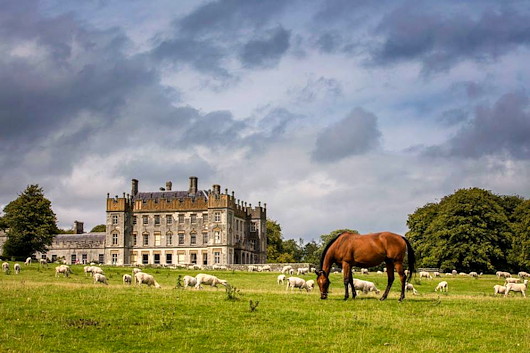
The County Carlow seat of the MacMorrough Kavanaghs, ancient Kings of Leinster, whose sixteenth generation live here still.
The Epiphany 6 January 2016

Architectural historian Gavin Stamp argues that if Rhodes really was such a vicious baddie as his opponents claim, why stop with just removing his statue?
South African academic and Rhodes scholar R. W. Johnson has compared the campaign to remove Rhodes statues to ISIL’s destruction of antiquities in the Middle East while clerical commentator Fr Alexander Lucie-Smith recalls the damnatio memoriae.
Most interesting perhaps is the treatment of Rhodes not in the ivory towers of Oxford or Cape Town but in the land that once bore his name. Rhodes’s grave still lies in a prominent spot in the Motopos, but even President Robert Mugabe is against exhuming him.
From the Telegraph:
The last time that a call was made for the grave in the Matopos to be exhumed, Middleton Nyoni, then Town Clerk of Bulawayo, offered a telling response. “It is the Taliban who destroy history – and I am not a Taliban,” he declared. “After Rhodes’s grave, who is next?”
When Rhodesia became Zimbabwe in 1980, the city fathers of Bulawayo shifted Rhodes’s statue from the town centre to the town museum, while covering up the plaque commemorating his indaba with the chiefs of the Matabele. But in 2010 the city council voted to uncover the plaque while last year the Zimbabwean playwright Cont Mhlanga provocatively suggested returning Bulawayo’s statue of Rhodes to its former place of prominence.
U.C.T. has dumped Rhodes – though he remains elsewhere on Table Mountain – and his statue is still at Oriel… for now.
– This time last year, Pascal-Emmanuel Gobry asked if the Christian revival was starting in France. My pilgrimage to Chartres provided me with evidence that the faith across the Channel is deep, strong, and growing.
Now, looking forward to the year ahead, P.E.G. notes that Catholic France used to be old and rural — now it is young and urban: “In the major cities, all the churches are full on Sunday morning, something unthinkable even 10 years ago.”
– Former CIA agent Philip Giraldi visits Russia for the first time.
— All across the world, evidence shows that poverty is dropping dramatically. Why then, Fraser Nelson asks, is it so hard to believe?
Bicycle polo at the Wellington Monument in the Phoenix Park, 1938.
Tuesday 5 January 2016

— It was once thought that when a key doctrine is abandoned or modified there is no turning back. But, writes Richard J Mouw at First Things, the turning-away from theological liberalism at Amsterdam’s Vrije Universiteit should make us think again.
— Christopher Akers at Quadrapheme argues Dostoevsky is right that beauty will save the world.
— Norfolk MP and former Guards officer Adam Holloway spent his teenage gap year fighting with the Afghan resistance against the Soviets.
An eccentric undergraduate in Edinburgh I knew exhibited a rare progressivism when she argued that in Afghanistan, the West should’ve backed the Soviets and backed them hard. I’m not convinced.
— “The overwhelming aesthetic is glam,” writes Nasri Atallah in his insider’s guide to Beirut for the Guardian. “People even dress up to go to the grocery store.”
— Underreported: Prince Charles has made a personal donation of £2,000 to St Patrick’s Church, the Catholic parish in Belfast targeted by Protestant Loyalist marchers.
A view in Manhattan
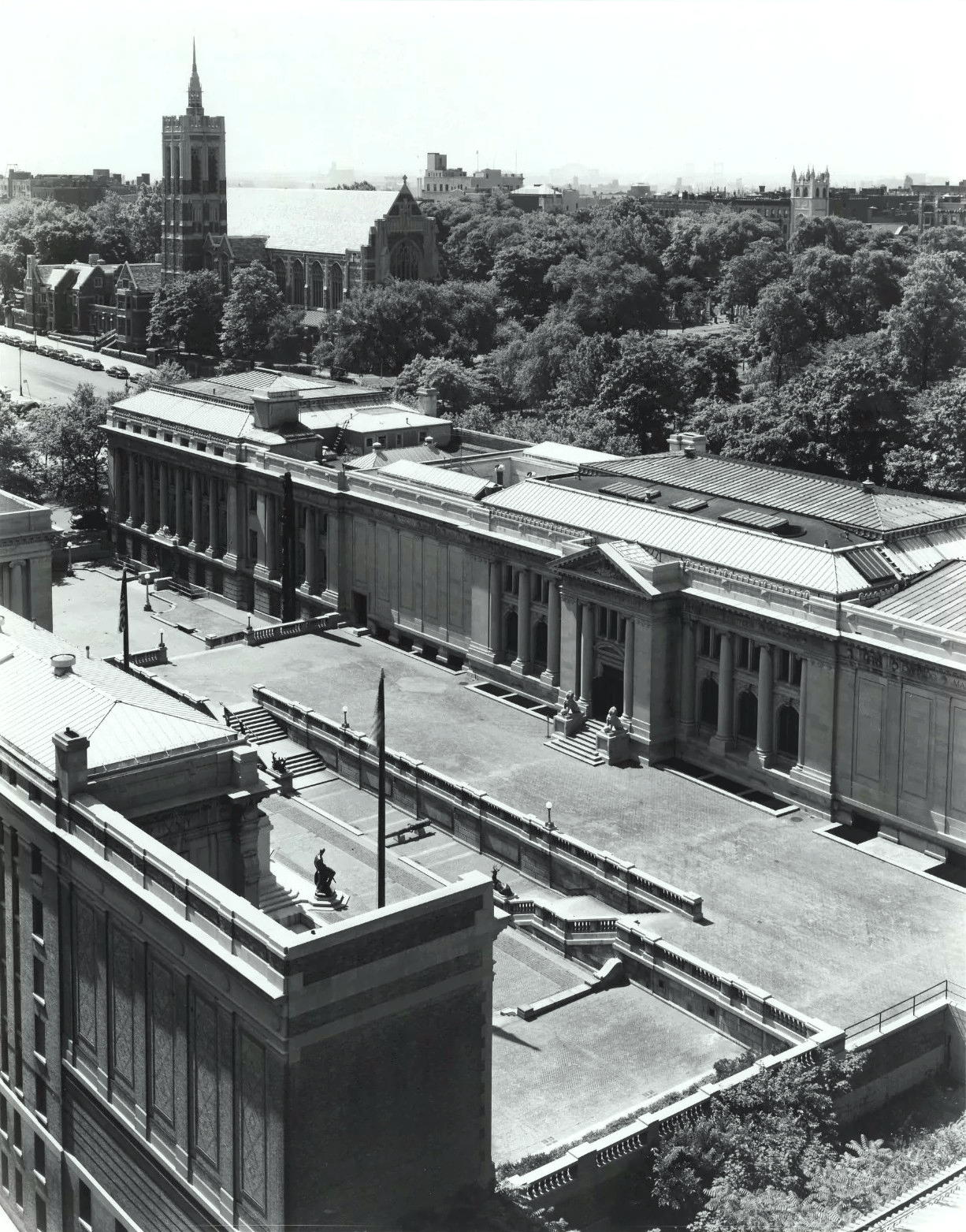
Search
Instagram: @andcusack
Click here for my Instagram photos.Most Recent Posts
- Sag Harbor Cinema March 26, 2025
- Teutonic Takeover March 10, 2025
- Katalin Bánffy-Jelen, R.I.P. March 3, 2025
- Substack Cusackiensis March 3, 2025
- In the Courts of the Lord February 13, 2025
Most Recent Comments
Book Wishlist
Monthly Archives
Categories


